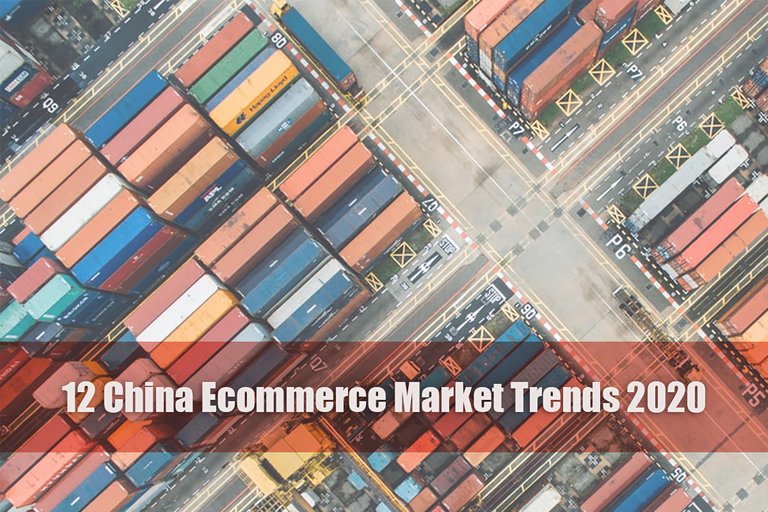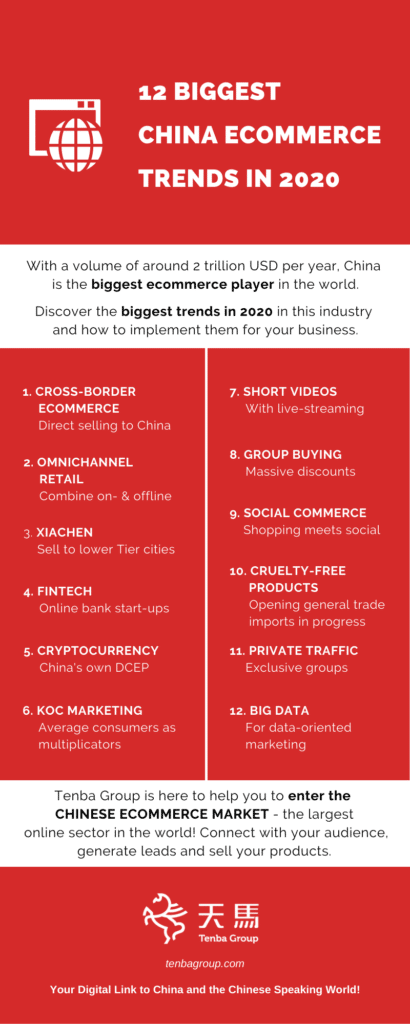
The China ecommerce market is the largest in the world with a volume of 1.94 trillion USD in 2019. That is plus 27% year over year and a quarter of China's total retail sales volume. As such, China’s ecommerce sector is more than three times the size of the US market, which ranks second. Despite the Coronavirus outbreak, these numbers are expected to grow in 2020.
This is why we are looking at the current trends in this week’s Tenba Group article. We present the main highlights of the Chinese ecommerce landscape in 2020.
The Online Commerce Players in China
In order to get an idea about China’s ecommerce market and online landscape let’s start with the largest online retailers:
- Tmall China by Alibaba Group
- This third most visited website in the world is a brand-driven B2C marketplace.
- JD.com
- Jingdong (JD) is a B2C marketplace with in-house delivery and logistics. Tmall relies on its sellers to fulfill the supply chain. And JD.com formed a strategic partnership with Tencent (WeChat) to take on Alibaba
- Kaola by NetEase
- This cross-border ecommerce player offers a large variety of goods, focusing on selling high-quality “Western” products to middle-class Chinese customers.
- Xiao Hong Shu (RED)
- The “Little Red Book” is a platform for young people’s lifestyle shopping. User-generated content (UGC) inspires this sharing community.

However, the exact market share among these online commerce platforms varies according to the source. Tmall is leading the ecommerce landscape with a market share of 50%-60%, JD.com follows with 15%-20%, Kaola and RED and others like WeChat (with their own WeChat store) divide the rest between them.
The Ecommerce Environment in China
Now, these are the ecommerce segments where China is a pioneer:
1. Mobile Commerce
We all know that internet users in China mostly browse on their phones or tablet. But did you know that mobile devices generate 80% of the retail ecommerce sales? This compares to the global average of 64%.
2. Mobile Payments
Chinese consumers rely on apps like Alipay, WeChat Pay, and UnionPay for online shopping and payments at physical stores alike. In fact, more than 80% of smartphone users in China use mobile payments compared to 27% in the US.
3. Cross-Border Ecommerce
We have already presented Chinese cross-border ecommerce in great detail in this article. It refers to international sales at an online market platform to Chinese consumers (B2C, B2B, C2C). High-quality luxury goods from abroad are very popular. In particular, cosmetics, baby products, food, and beverages (organic), high-fashion, and jewelry.
Global infrastructure improves and small businesses gain better access to global markets. Therefore, the demand of Chinese consumers for household products and luxury goods will only increase.
Now that we have covered the basics, let’s look at the Chinese ecommerce trends in the year 2020.
12 Trends in the China Ecommerce Market in 2020
In the past, China was known as the “world factory”, exporting high-quality fashion, sneakers, electronics, and more. Over the last years, this trend has seen a reverse - imports are becoming more and more relevant.

Now, let’s get to it and look at this year's biggest trends in the Chinese ecommerce environment:
1. Cross-Border Ecommerce
This booming sector will supposedly reach a volume of 164 billion USD in 2020, almost double compared to the previous year.
Moreover, Alibaba’s acquisition of Kaola in September 2019 will lead to a consolidation in this segment. Kaola will become a part of Tmall, stealing market share from competitor JD.com.
Foreign brands can cooperate with these platforms depending on their business model to sell their services. More about the CBEC trade in China here.
2. Omnichannel Retail
This cross-channel content strategy aims at improving the user experience and creating better relationships with the target audience across all points of contact. Whether you are shopping online or in an actual store, the transition from one point to the other at any point in your consumer journey should be seamless and easy - online and offline are melting together (O2O).
In particular, China is leading omnichannel retailing in high customer expectations, smart sales assistants, mobile-first, self-service kiosks, and virtual reality / augmented reality. In addition, close integration of consumer payments is creating a best practice example for the whole world.
A real-life example is Alibaba’s grocery platform Freshippo where customers can shop in person (click-and-collect), dine-in, and have goods delivered via online ordering.
3. Xiachen
This trend of selling to lower Tier cities and areas in China we already observe in the Chinese social media landscape. Lower Tiers have more money available for shopping (due to lower living costs) and are happy to spend it on consumer goods.
4. Fintech
Financial technology and innovation which aims to compete with traditional methods to deliver financial services are on the rise. In particular, Chinese online banks like WeCash (unrelated to WeChat or Tencent) emerge as startups to bring easy and uncomplicated financial services to individuals and institutions, often incorporating machine learning and AI technology.
For example, WeCash with 130 million users in 5 countries allows individuals to get their credit score straightforward and apply for loans. And institutions can build their income-yielding loan portfolio on this big-data powered platform.
5. Cryptocurrency
Cryptocurrency miners and users are facing severe regulation in the Middle Kingdom. Same as with social network platforms, a designated Chinese search engine (Baidu) and other China-specific tools and regulations, China is seeking new solutions for their country and market in terms of cryptocurrency.
First introduced as a concept 5 years ago, China is now finalizing the preparation for the release of its DCEP (Digital Currency/Electronic Payments). However, unlike Bitcoin and related currencies, DCEP is government-sanctioned. The government will likely distribute the new currency through traditional banks, making it fully centralized and exactly like traditional paper money.
As China expands its worldwide trade through the belt and road initiative (BRI) and other development initiatives, DCEP has the potential to create significant financial autonomy and less exposure to the US.
6. From KOL to KOC marketing
Key opinion consumers (KOCs) are “normal” buyers who create videos and posts about their own product reviews and recommendations. End consumers are hungry for advice and recommendations from real consumers they trust. KOCs also act as influencers but are more authentic. Relationship-based marketing is on the rise!
Brands that incorporate KOCs into their marketing strategy can benefit from a boost in the brand image and increased sales. Make sure to identify suitable KOCs, as they usually do not have many followers, which makes them difficult to find. A Chinese marketing agency can take care of this for you.
If you incorporate these trends, your business has a solid basis in Chinese marketing. Do you want to hear more about the Chinese ecommerce environment ...? Continue reading!
7. Short Videos
Together with live-streaming, short videos and short video apps are conquering the Chinese market. Thus, the line between business and socializing continues to blur. It will not surprise you that more than 300 million Chinese are using short video apps.
Higher Tier areas with middle and higher-income households and individuals as well as a younger audience (under 35 years old) are more drawn to this medium.
8. Group Buying
This trend hasn’t really arrived outside of China yet. Western shoppers may think that the products could have poor quality. Or that those platforms are unreliable and impose hidden costs. Chinese consumers value the significantly reduced prices - particularly lower Tier residents take advantage of the group-buying model.
In the Middle Kingdom, however, group buying is expected to grow as Pinduoduo, JD.com, and Alibaba launch their own group-buying functions.
9. Social Commerce
This hot new trend reached a volume of more than 300 billion USD in 2019. The increased use of mobile devices and social media created social shopping also known as social ecommerce.
The “now” consumer follows trends and has unplanned interactions with brand and retail experiences. Shoppers can do so at home, at work, or on the go. This behavior drives the need for new approaches to create a personal and ready-to-buy social commerce experience.
10. Cruelty-Free Products
As the pressure on China’s policy-makers is increasing, decision-makers are opening the general trade for cruelty-free products bit by bit. Up until now, cosmetics sold in China have to be tested on animals by law - it is the only country with such a regulation.
Not only animal rights activists will be happy to hear that China now moves away from these mandatory tests. This also opens up the market to vegan, cruelty-free and sustainable cosmetics and beauty brands. The UK-based skincare brand Bulldog is set to be the first cruelty-free cosmetics brand to sell in mainland China, imported under the general trade (and not cross-border ecommerce).
11. Private Traffic
As a result of paid traffic getting more expensive, brands are seeking alternatives. By setting up exclusive clubs or groups like WeChat groups, brands can communicate a certain lifestyle and the corresponding products.
The advantage of a closed group is that they already consist of loyal customers and fans. And they respond more easily to CTAs.
12. Big Data
This last trend brings all the previous ones together, literally. Big data analyzes massive volumes of information to apply data-oriented marketing in China. By combining information from online and offline consumer behavior, businesses overcome the limits of space and time. Businesses gain deep insights into the likes and dislikes of their (potential) customers, their movement, and behavior patterns.
For example, Tencent collects and classifies information into different dimensions, which consist of more than 3,000 tags, including basic attributes, social interests, entertainment interests, media preferences, etc.
Keep in mind that Chinese consumers love their mobile devices and use them for everything. Specifically, their super-app WeChat, which lets users pay, play, chat, shop, order everyday services and products, and more. Advertising in China has never been easier and more complex at the same time.
So, this sums up our 12 trends in 2020 in the China ecommerce market.
The Takeaway
To summarize, the China ecommerce market is leading online commerce worldwide. You are now familiar with the key players in this segment and the general ecommerce environment in China. Moreover, you now know the 12 China ecommerce trends to follow in 2020.

Therefore, set up your own website for the Chinese market and implement an ecommerce solution! Stay ahead with your business in China and around the world by optimizing your online presence for search engines - Baidu SEO (leading in China) and Google SEO.
After all, if you’re not sure where to start or you want to focus on other aspects of your business, simply let Tenba Group, your trusted China online marketing company, help you with this. We also offer many other services like sourcing products from China, China influencer marketing, and more.
Posted from my blog with SteemPress : https://tenbagroup.com/12-china-ecommerce-market-trends-2020/